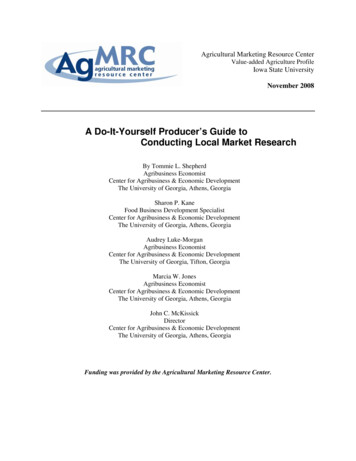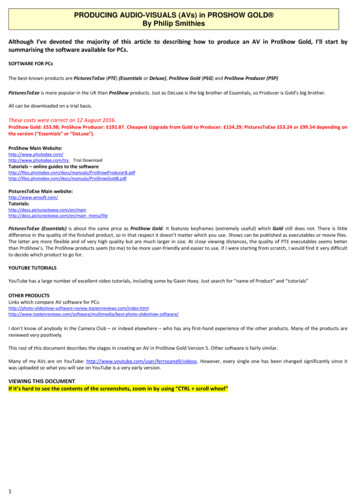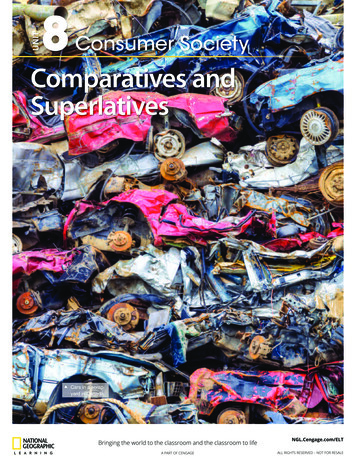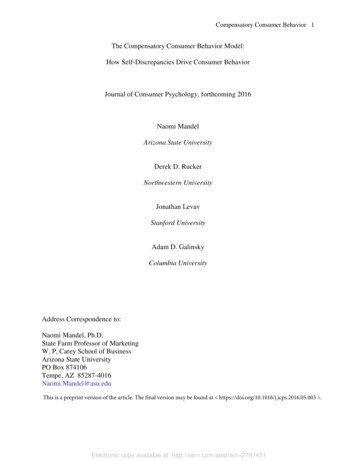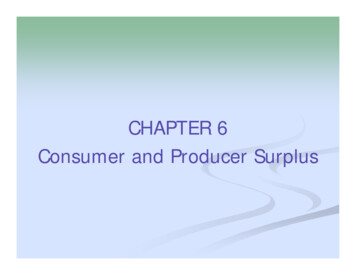
Transcription
CHAPTER 6Consumer and Producer Surplus
What you will learn in this chapter:How much benefit do producers and consumersreceive from the existence of a market?How is the welfare of consumers and producersaffected by changes in market prices?How are these concepts related to demand andsupply curve?¾ Consumer Surplus¾ Producer Surplus¾ Cost¾ Market Failure2
Consumer Surplus and the Demand CurveIndividual consumer surplus is the net gain to anindividual buyer from the purchase of a good. It isequal to the difference between the buyer’s willingnessto pay and the price paid.Total producer surplus in a market is the sum ofthe individual producer surpluses of all the sellers of agood.3
The Demand Curve for Used Textbooks4
5
Consumer SurplusThe total consumer surplus generated by purchases of a good ata given price is equal to the area below the demand curve but6above that price.
A Fall in the Price of Used Textbooks7
A Fall in the Market Price IncreasesConsumer Surplus8
Producer Surplus and the Supply CurveA potential seller’s cost is the lowest price at whichhe or she is willing to sell a good.Individual producer surplus is the net gain to aseller from selling a good. It is equal to thedifference between the price received and theseller’s cost.Total producer surplus in a market is the sum ofthe individual producer surpluses of all the sellers ofa good.9
The Supply Curve for Used Textbooks10
Producer Surplus in the Used-TextbookMarket11
Producer SurplusThe total producer surplus from sales of a good at a given price isthe area above the supply curve but below that price.12
A Rise in Price Increases Producer Surplus13
Putting it together: Total SurplusThe total surplus generated in a market is thetotal net gain to consumers and producers fromtrading in the market. It is the sum of theproducer and the consumer surplus.The concepts of consumer surplus and producersurplus can help us understand why markets arean effective way to organize economic activity.14
Total Surplus15
Consumer Surplus, Producer Surplus,Gains from Trade and Efficiency ofMarketsBoth consumers and producers are better offbecause there is a market in this good, i.e. thereare gains from trade.The maximum possible total surplus (highestpossible gain to society) is achieved at marketequilibrium.In the market equilibrium there is no way to makesome people better off without making othersworse off Æ markets are efficient.16
Reallocating Consumption LowersConsumer Surplus17
Reallocating Sales Lowers ProducerSurplus18
Changing the Quantity Lowers TotalSurplus19
The market equilibrium maximizes totalsurplus because the market performs fourimportant functions:1. It allocates consumption of the good to the potentialbuyers who value it the most.2. It allocates sales to the potential sellers who mostvalue the right to sell the good.3. It ensures that every consumer who makes apurchase values the good more than every seller whomakes a sale.4. It ensures that every potential buyer who doesn’tmake a purchase values the good less than everypotential seller who doesn’t make a sale.20
Applying Consumer and Producer Surplus:The Efficiency Costs of a Tax¾ A tax causes a deadweight loss to society, becauseless of the good is produced and consumed than inthe absence of the tax. As a result, some mutuallybeneficial trades between producers and consumersdo not take place.21
A Tax Reduces Consumer and ProducerSurplus22
The Deadweight Loss of a Tax23
Deadweight Loss and ElasticitiesThe general rule for economic policy is that otherthings equal, you want to choose the policy thatproduces the smallest deadweight loss. But how canwe predict the size of the deadweight loss associatedwith a given policy?For a tax imposed when demand or supply, or both,is inelastic will cause a relatively small decrease inquantity transacted and a small deadweight loss.24
25
26
The End of Chapter 6coming attraction:Chapter 7:Making Decisions27
seller from selling a good. It is equal to the difference between the price received and the seller's cost. Total producer surplus in a market is the sum of the individual producer surpluses of all the sellers of a good. 10 The Supply Curve for Used Textbooks. 11


